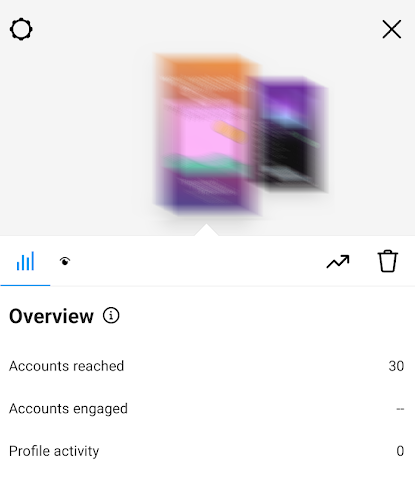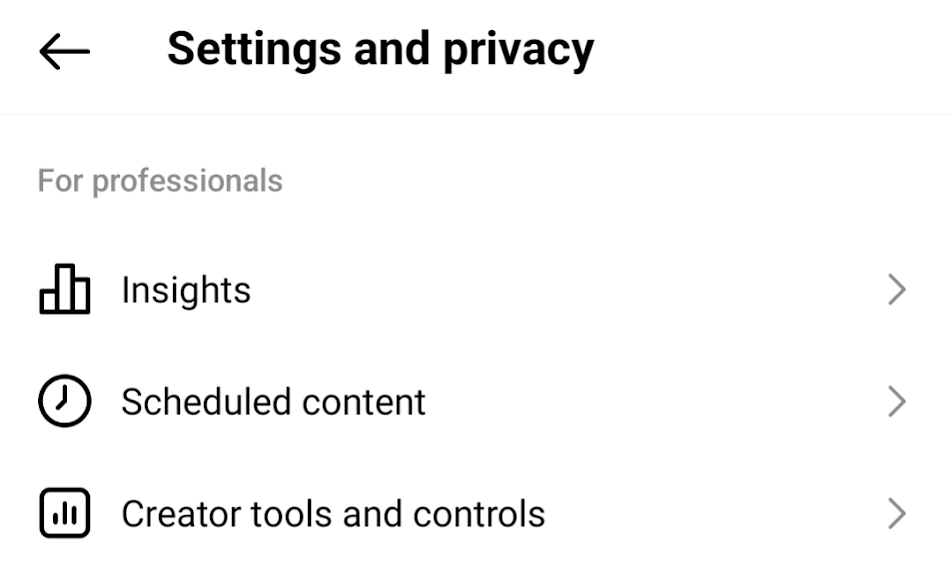Be honest: how often do you check your Instagram Story analytics?
Because interactions with Stories are crucial for business accounts to track.
Brands rely on Stories to stay front-and-center in followers’ feeds. Stories are also among Instagram’s most popular and engaged-with features.
From content formats to messaging and more, Stories are a goldmine of marketing data.
That said, it’s easy to overlook siloed Story data among the rest of your Instagram analytics.
Below we explain how to check Instagram Story analytics and identify actionable insights.
What are Instagram Story analytics?
Instagram Story analytics represent the measurement of your IG Stories performance.
The metrics you can track via Instagram analytics are broken down into three types:
- Engagement metrics that measure interactions (ex: likes, shares and replies)
- Reach metrics that measure the total impressions and accounts reached by your Stories
- Navigation metrics that track actions taken by Story viewers (ex: taps back, DMs and more)

How to see your Instagram Story analytics
Chances are you already check your real-time analytics when your Stories are live.
However, your performance data doesn’t disappear when your Stories do after 24 hours.
If you’re only tracking single Stories as they happen, you’re missing out on bigger trends and insights. The good news? IG now aggregates your Stories data for up to two years.
More good news: there are multiple ways to view your Instagram Story analytics ASAP. This includes Instagram’s native Insights and reporting with tools like Sprout Social.
Note: you need either a business or creator account to access your Stories data.
How to view Instagram Story analytics using Instagram Insights
Granted you have the appropriate account type, below is a snapshot of the steps involved.
Step 1. Tap the (?) menu from your profile to access “Settings and privacy.”

Step 2. Scroll and select “Insights” (found under “For professionals” in a creator account).

Step 3. At the Insights menu, scroll down and select the “Content You Shared” menu. Tap “Stories” when prompted to select a content type.


Step 5. Tap a specific Story for a detailed breakdown of its analytics and performance data.


And you’re good to go!
Note: You can also track your Instagram Stories analytics via Story Highlights. Simply go to your highlights and tap “Activity” on the Story you want to measure. You can see most of the same metrics as above. While you cannot see viewers on your Stories, you can see people who “Liked” them.
How to see your Instagram Story analytics using Sprout Social
Sprout Social’s suite of Instagram analytics tools makes it easy to uncover your Story data. The bonus of using Sprout is the ability to track performance alongside all of your brand’s content.
Here’s how to measure your Stories with Sprout’s Instagram Business Profiles report:
Step 1. Once you’re logged into your Sprout Dashboard, go to “Overview.”
Step 2. Select a business profile or account to analyze using the “Filter” option.
Step 3. Select “Performance Summary.”
Step 4. Select “Stories performance.”
Step 5. Select a date range for your Stories. You’ll then see a breakdown of various reports and performance metrics.

Now, let’s look at the process when using the Post Performance report in Sprout Social. Assuming you’re logged in, here’s all you need to do:
Step 1. Select the Instagram profile(s) you want to view Story analytics for.
Step 2. When prompted to choose between Post Types, select “Story.”


6 Instagram Story metrics you should be tracking
Keeping an eye on your Instagram metrics goes hand in hand with growing your account.
Because data can clue you in on what’s working and what’s not when it comes to engagement.
But again, tracking Story metrics can be tricky because they’re kind of siloed on their own.
This signals the value of using a tool like Sprout Social. The platform seamlessly filters specific Story metrics and offers in-depth reports for them. This means you can focus on your priority metrics and stop digging through IG Insights.

But what metrics should you be tracking when checking your Instagram Story analytics? Sure, interactions and engagements are obviously crucial. They aren’t the only ones, though.
Below are some additional data points to consider that often get swept under the rug.
Story Replies
Story replies are the number of Instagram DMs you received on your Story during its lifetime.
Getting unprompted (positive!) replies from your Stories means you’re nailing your content. More interactions and engagement signal strong relationships and loyalty with your audience.
If you’re lacking in Story Replies, you may want to consider a more direct response to your posts. Not to mention inserting more calls-to-action (but more on that later).
Story Taps Back
Story Taps Back are the number of times people tapped to return to your previous Story.
These are interesting because they offer insight into Stories beyond the post you’re tracking.. For example, taps back can highlight how a previous post in a series of Stories was notable. This doesn’t necessarily mean the post you’re looking at was “bad” or “boring,” though.
This highlights the importance of looking at your Instagram Stories analytics holistically. Context matters, especially when publishing multiple Story posts side-by-side.
Story Taps Forward
Story Taps Forward are the number of times people tapped your current Story to move on to your next Story.
You can think of taps forward as a sort of bounce rate or retention metric. If you post a series of Stories and someone sticks around for all of them, that’s typically a good sign.
On that note, taps forward can also highlight how long your brand’s series of Stories should be. Maybe you retain most viewers with five Stories but see a big drop-off beyond that. If so, you should keep that in mind next time you make a series of posts.
Consider also that taps can also happen out of impatience. You have to read between the lines here since you can’t monitor the amount of time spent on your Stories. Again, context matters.
Story Exits
Story Exits are the number of times people swiped to stop viewing your Story during its lifetime.
Pay close attention to exits, especially when experimenting with new types of Stories. For example, you might see a spike in exits during video Stories or after posting a long series.
If so, take note and keep that in mind for your upcoming content strategy. While Story Exits don’t necessarily mean any given Story was “bad,” they can signal the following:
- Your series of Stories was too long (think: seeing 10+ Stories slides might turn users off)
- Your content was repetitive or redundant
- Your audience wasn’t interested in your Story
Story Impressions
Story Impressions are the number of times your story was displayed to users during its lifetime.
The more eyes on your Stories, the better! Earning impressions beyond your own followers is also a positive sign for your Stories. Take note of Stories with the highest impressions.
Average Reach Per Story
Average Reach Per Story is the average number of unique users who viewed your story during its lifetime.
Ideally, your average reach per Story should grow alongside your account. This highlights the importance of consistently measuring your Instagram data. Otherwise, you won’t know whether your posts are moving the needle.
Speaking of, Sprout makes it a cinch to consolidate all of these metrics (and more). Seeing your Stories data alongside the rest of your IG performance offers a holistic understanding of what’s working and what’s not.

Tips for optimizing your strategy using Instagram Story analytics
Tracking your Instagram Story analytics is obviously important. But what about actually seeing those numbers move in the right direction?
To wrap things up, let’s dig into how to optimize your Instagram marketing and earn engagement with Stories.
Take advantage of interactive Instagram Story features
Don’t’ sleep on all of the Instagram features built specifically to engage your Story viewers.
Stickers serve as a natural way to earn interactions and serve as creative calls-to-action. While not every Story needs a sticker, brainstorm ways to integrate interactive elements like:
- Polls
- Quizzes
- Sliders
- Countdowns
- Emoji reactions
- Links

Stickers can help you come across as engaging with your audience versus talking at them. Not to mention they help inject a sense of personality into your calls-to-action.

Feature UGC and tag other accounts in your Stories
Anything you can do to feed the IG algorithm is a plus. That means driving tags, shares and interactions with your audience and customers.
Note that many retail brands use Stories as a place to highlight UGC beyond their feeds.

This is a low-hanging way to get additional shares and more eyes on your content as creators repost your content. This can be done for organic UGC and content from influencers alike.
Over time, you can assess which types of UGC Stories earn the most engagement. This gives you opportunities to refine your content strategy even further.
Share your Stories at the best times for engagement
We’ll bite: Stories are tricky when it comes to picking best times to post. Unlike Reels or Carousel posts, it’s pretty standard for brands to publish multiple Stories throughout the day.
That said, you can still try to stick to times where Instagram users are typically most engaged.

Picking the “best” time for your brand depends on a few variables, though. Consider:
- A consistent cadence of Stories means you’ll stay visible in your followers’ feeds. Try spreading your Story posts throughout the day versus dumping them all at once.
- On the flip side, you may find that a rapid-fire cadence works best for your audience. This speaks to the importance of checking your Instagram Story analytics. Don’t assume!
- If you schedule Stories with Sprout, you can hit your desired frequency without posting in real-time.
Many brands will publish a series of three-to-five Stories side-by-side for promotions. This is in addition to consistently republishing their Reels or Carousels to their Stories. Finding a publishing frequency that makes sense for your brand requires some trial-and-error.

Use Instagram audience insights to guide your content formats
Not to sound like a broken record but every brand’s Instagram target audience is different.
Some audiences prefer videos while others skip them. You might find that your followers love polls and going back-and-forth with you. Maybe you actually find you earn more Stories engagement when you post less.
Regardless, you need to keep a constant pulse on your Instagram analytics to make informed decisions. With a tool like Sprout, you can pick your prioritize metrics across IG and track them with ease.

What can you learn from your Instagram Story analytics?
Given how competitive Instagram has become for brands, tracking your metrics is a must-do.
But Stories require special attention.
The fact that you can publish them so often versus other post types is a gift for marketers. Stories offer a way to consistently learn from your audience and figure out what makes them tick.
However, making the most of that data requires consistency and context. That’s exactly where Sprout Social comes in clutch as you track all of your brand’s Instagram analytics in one place.
If you haven’t already, check out Sprout’s Instagram analytics features to see what insights your brand can learn to grow engagement faster.